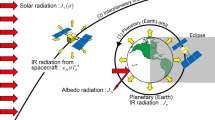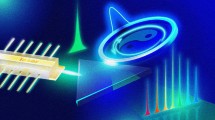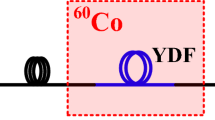Abstract
We present the complete characterization of a laser setup for rubidium cooling dedicated to space applications. The experimental setup is realized with commercial off-the-shelf fiber components suitable for space applications. By frequency doubling two fiber laser diodes at 1560 nm, we produce the two optical frequencies at 780 nm required for atomic cooling of 87Rb. The first laser is locked on saturated absorption signal and long-term frequency drift has been canceled using a digital integrator. The optical frequency of the second laser is controlled relatively to the first one by a frequency comparison method. A full characterization of the setup, including frequency stability evaluation and frequency noise measurement, has been performed. The optical frequency doubling module has been submitted to environmental tests to verify its compatibility with space applications.








Similar content being viewed by others
References
Y. Sortais, S. Bize, M. Abgrall, S. Zhang, C. Nicolas, C. Mandache, P. Lemonde, P. Laurent, G. Santarelli, N. Dimarcq, P. Petit, A. Clairon, A. Mann, A. Luiten, S. Chang, C. Salomon, Phys. Scripta T95, 50–57 (2001)
A. Peters, K.Y. Chung, S. Chu, Metrologia 38, 25–61 (2001)
A. Gauguet, B. Canuel, T. Lévèque, W. Chaibi, A. Landragin, Phys. Rev. A 80, 063604 (2009)
J.M. Hogan, D.M.S. Johnson, S. Dickerson, T. Kovachy, A. Sugarbaker, S. Chiow, P.W. Graham, M.A. Kasevich, B. Saif, S. Rajendran, P. Bouyer, B.D. Seery, L. Feinberg, R. Keski-Kuha, Gen. Relativ. Gravit. 43, 1953–2009 (2011)
P. Cladé, E. De Mirandes, M. Cadoret, S. Guellati-Khelifa, C. Schwob, F. Nez, L. Julien, F. Biraben, Phys. Rev. Lett. 96, 033001 (2006)
P. Wolf, F. Chapelet, S. Bize, A. Clairon, Phys. Rev. Lett. 96, 060801 (2006)
R. Geiger, V. Ménoret, G. Stern, N. Zahzam, P. Cheinet, B. Battelier, A. Villing, F. Moron, M. Lours, Y. Bidel, A. Bresson, A. Landragin, P. Bouyer, Nat. Commun. 2, 474 (2011)
Q. Bodart, S. Merlet, N. Malossi, F. Pereira dos Santos, P. Bouyer, A. Landragin, Appl. Phys. Lett. 96, 134101 (2010)
Y. Bidel, O. Carraz, R. Charrière, M. Cadoret, N. Zahzam, A. Bresson, Appl. Phys. Lett. 102, 144107 (2013)
L. Cacciapuoti, N. Dimarcq, G. Santarelli, P. Laurent, P. Lemonde, A. Clairon, P. Berthoud, A. Jornod, F. Reina, S. Feltham, C. Salomon, Nucl. Phys. B 166, 303 (2007)
L. Cacciapuoti et al., STE-QUEST Science Requirements Document, FPM-SA-DC-00001, issue 2, revision 3 (2012) . http://sci.esa.int/ste-quest/
H. Müntinga et al., Phys. Rev. Lett. 110, 093602 (2013)
X. Baillard, A. Gauguet, S. Bize, P. Lemonde, P. Laurent, A. Clairon, P. Rosenbusch, Opt. Commun. 266, 609 (2006)
M. Schmidt, M. Prevedelli, A. Giorgini, G.M. Tino, A. Peters, Appl. Phys. B 102, 11 (2011)
G. Stern, B. Allard, M. Robert-de-Saint-Vincent, J.P. Brantut, B. Battelier, T. Bourdel, P. Bouyer, Appl. Opt. 49, 3092 (2010)
V. Ménoret, R. Geiger, G. Stern, N. Zahzam, B. Battelier, A. Bresson, A. Landragin, P. Bouyer, Opt. Lett. 36, 4128 (2011)
S.S. Sané, S. Bennetts, J.E. Debs, C.C.N. Kuhn, G.D. McDonald, P.A. Altin, J.D. Close, N.P. Robins, Opt. Express 20, 8915 (2012)
D.A. Steck, Rubidium 87 D Line Data, http://steck.us/alkalidata, revision 2.1.4 (2010)
Keopsys, 2W, Ref. CEFA-C-PB-HP-PM-33-NL1-OM1-B202-FA-FA and Alphanov, 1W, Ref. EDFA-1560-30-P
K. Numata, J. Camp, M.A. Krainak, L. Stolpner, Opt. Express 18, 22781 (2010)
Generic Reliability Assurance Requirements for Optoelectronic Devices Used in Telecommunications Equipment, Telcordia, GR-468-CORE no. 2 (2004)
K. Numata, J. Camp, in Proceedings of 9th LISA Symposium, APS Conference Series, vol. 47, ed. by G. Auger, P. Binétruy, E. Plagnol (Astronomical Society of the Pacific, 2012)
S. Girard, M. Vivona, A. Laurent, B. Cadier, C. Marcandella, T. Robin, E. Pinsard, A. Boukenter, Y. Ouerdane, Opt. Express 20, 8457 (2012)
J. Thomas, M. Myara, L. Troussellier, E. Burov, A. Pastouret, D. Boivin, G. Mélin, O. Gilard, M. Sotom, P. Signoret, Opt. Express 20, 2435 (2012)
This test is described in MIL-STD883, Method 2026, test condition 1F
J.L. Hall, L. Hollberg, T. Bear, H.G. Robinson, Appl. Phys. Lett. 39, 680 (1981)
T. Udem, R. Holzwarth, T.W. Hänsch, Nature 416, 233 (2002)
O. Pajot, F. Vernotte, C. Plantard, P.M. Mbaye, Electron. Lett. 48, 329 (2012)
Acknowledgements
We would like to thank AdvEOTec company for environmental characterization of the frequency doubling module. We also thank F.X. Esnault and A. Gauguet for fruitful discussions and careful readings. We thank M. Lours from SYRTE laboratory for providing electronic locking modules.
Author information
Authors and Affiliations
Corresponding author
Environmental tests
Environmental tests
In this part, we give the results of the life tests and environmental tests performed on the wavelength conversion module. The conversion efficiency η and the phase-matching temperature T pm were measured for an input power of P in = 20 mW before and after each test. These two parameters are determined with a respective relative uncertainty of 13 and 5% at 3σ. The life tests, reported in Table 1, were performed during 2000 h on three different devices (D1, D2 and D3). The environmental tests, chronologically reported in Table 2, were carried on the device D2.
Rights and permissions
About this article
Cite this article
Lévèque, T., Antoni-Micollier, L., Faure, B. et al. A laser setup for rubidium cooling dedicated to space applications. Appl. Phys. B 116, 997–1004 (2014). https://doi.org/10.1007/s00340-014-5788-z
Received:
Accepted:
Published:
Issue Date:
DOI: https://doi.org/10.1007/s00340-014-5788-z




